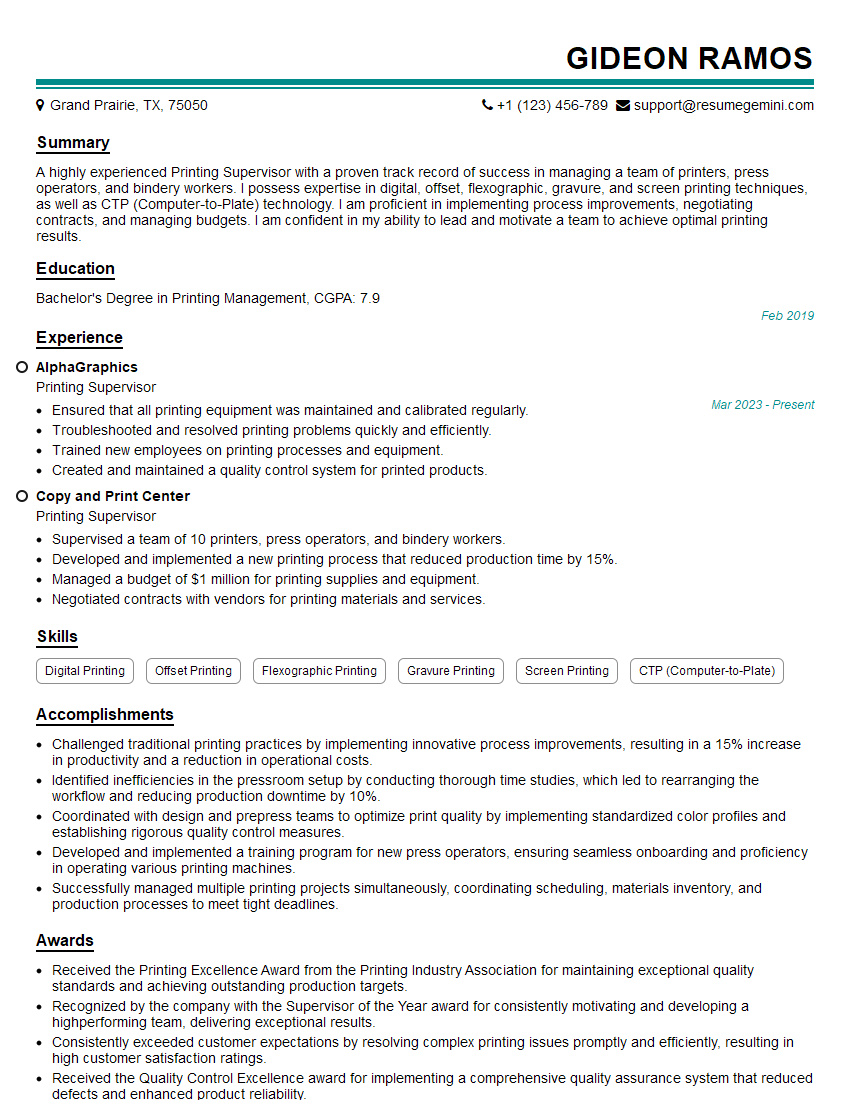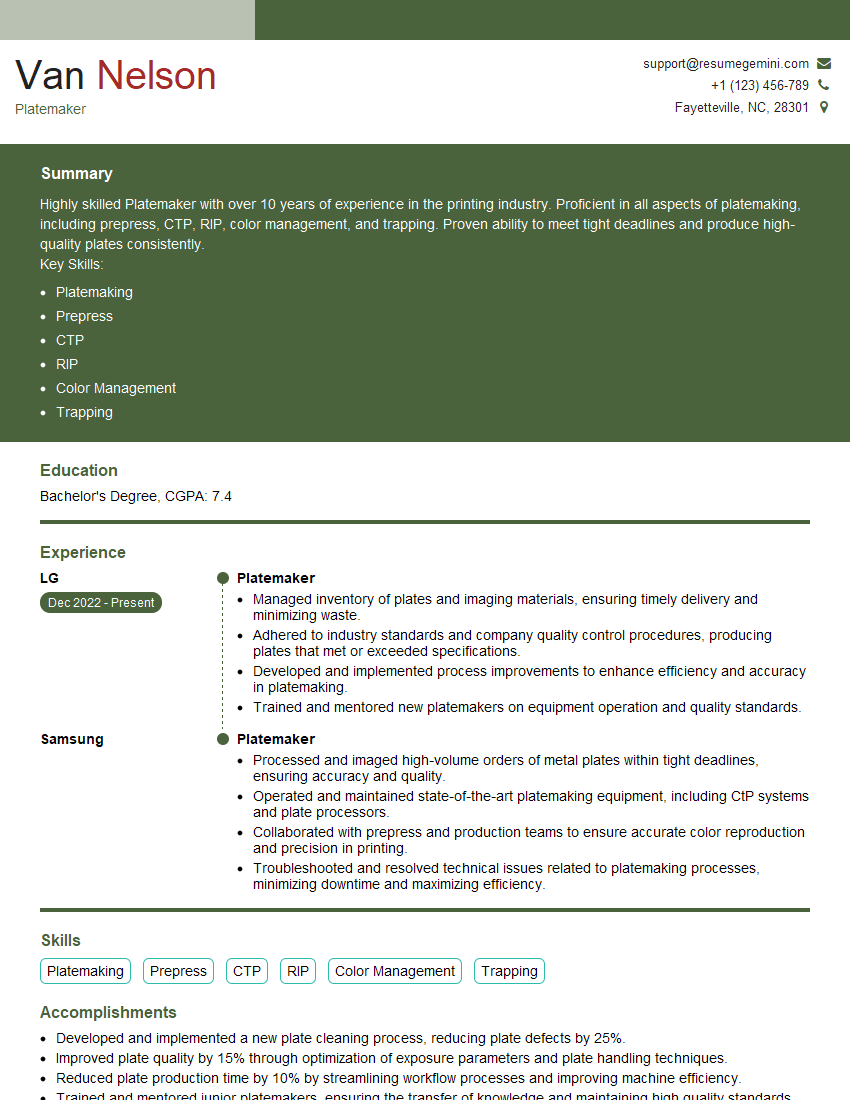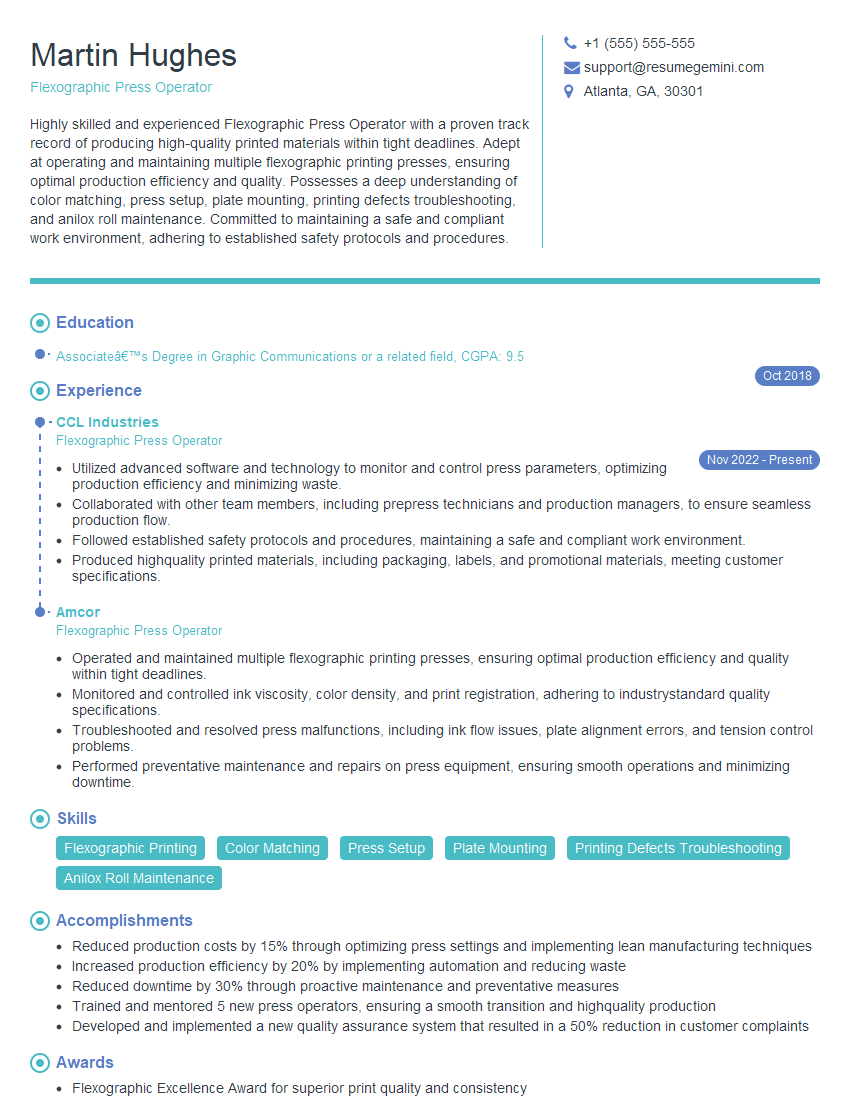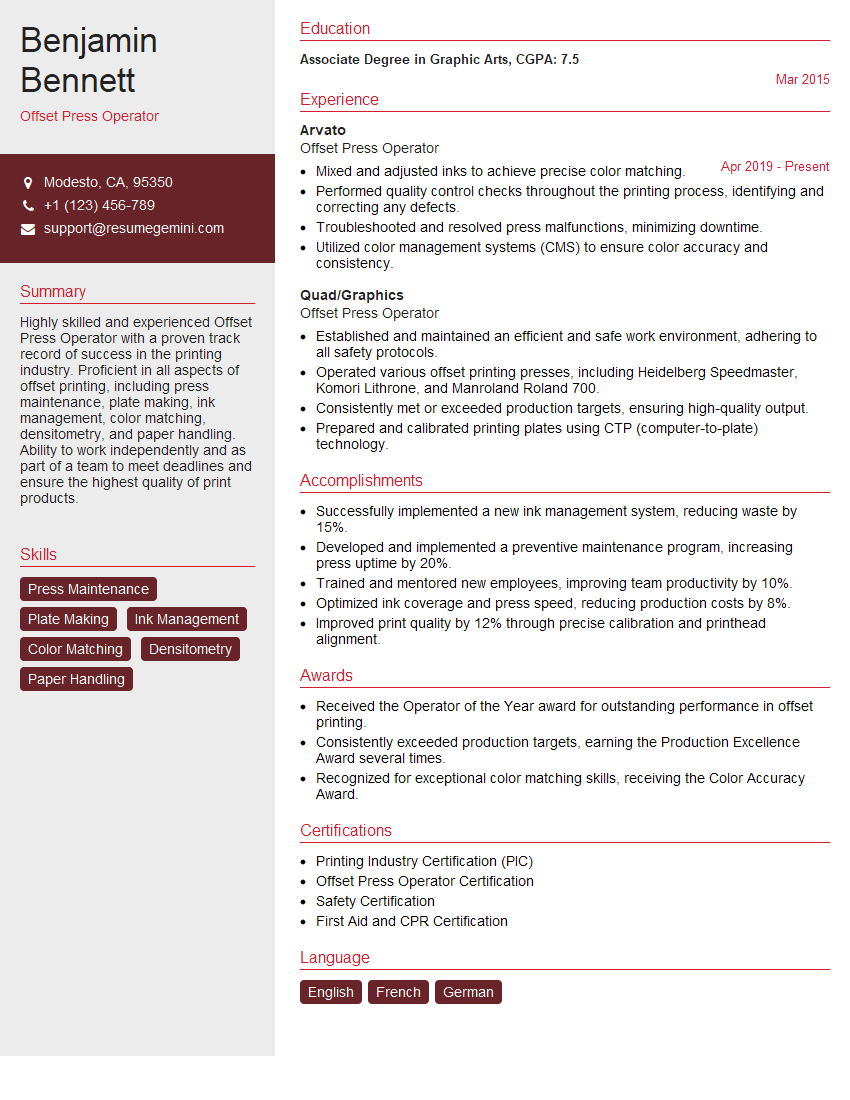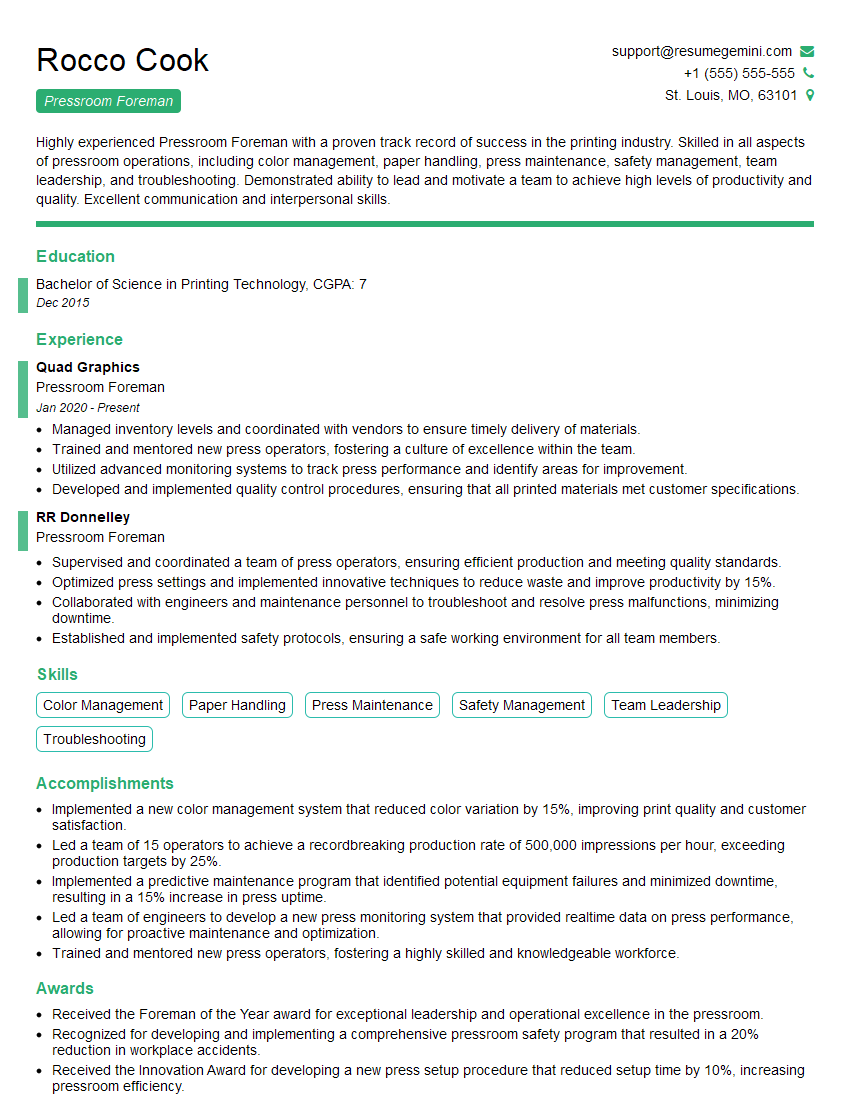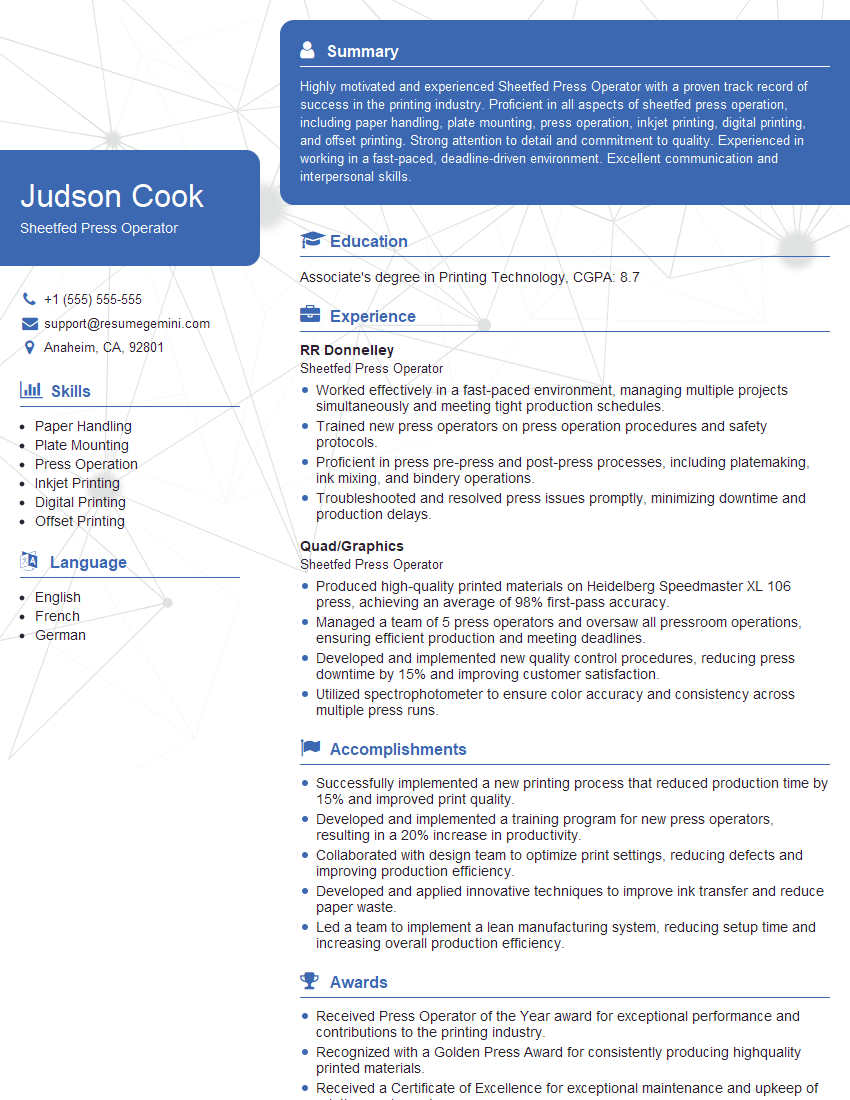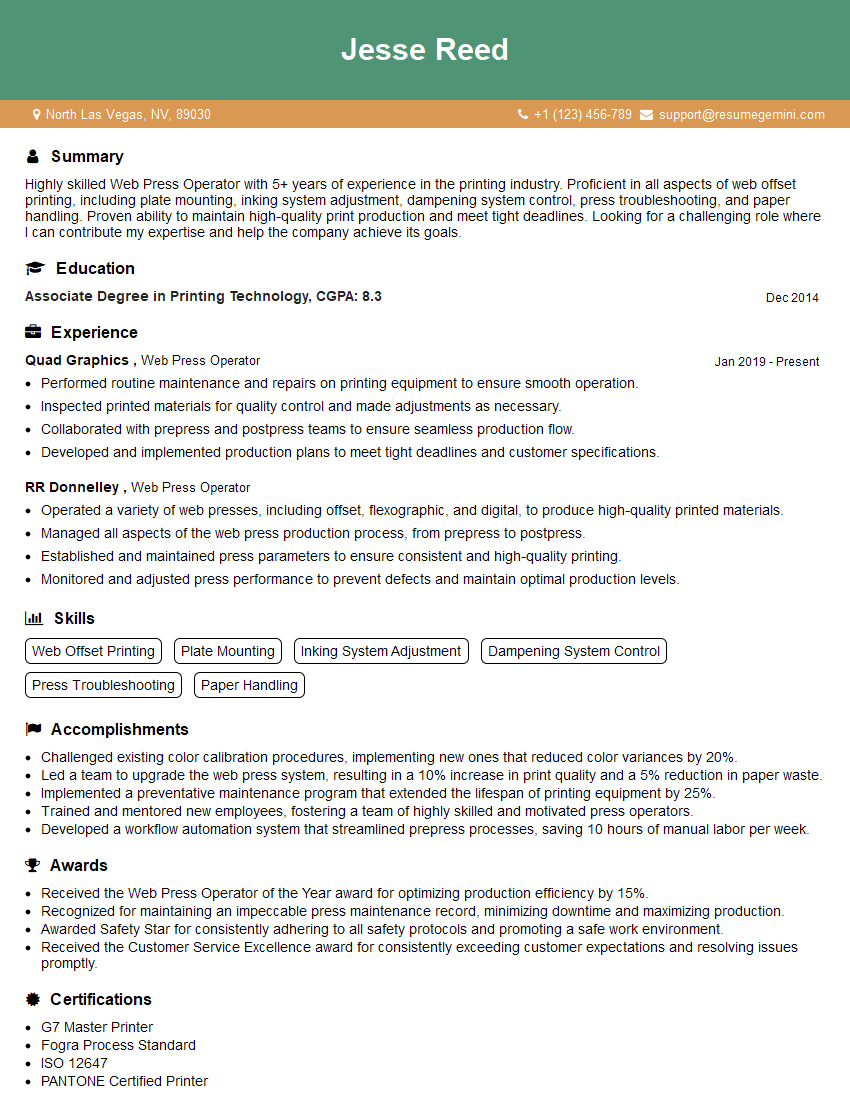Interviews are more than just a Q&A session—they’re a chance to prove your worth. This blog dives into essential Understanding of printing press makeready interview questions and expert tips to help you align your answers with what hiring managers are looking for. Start preparing to shine!
Questions Asked in Understanding of printing press makeready Interview
Q 1. Describe the process of plate mounting on a Heidelberg Speedmaster.
Mounting plates on a Heidelberg Speedmaster is a precise process crucial for achieving accurate registration. It involves several steps, starting with careful inspection of both the plate and the plate cylinder. Any damage to the plate needs to be addressed before mounting. We then use a plate-mounting adhesive, ensuring a thin and even layer is applied to prevent air bubbles. The plate is carefully positioned on the cylinder, using alignment pins as guides to ensure perfect registration with the other printing units. A roller is then used to firmly secure the plate onto the cylinder, removing any air pockets. Finally, a visual inspection is conducted to confirm proper adhesion and alignment before proceeding to the next step, which is often a test print to verify registration.
For example, on a six-color press, we might need to mount six plates, each requiring precise alignment to ensure that the colors accurately overlap. A misaligned plate can result in blurry images or color shifts, leading to significant waste and reprint costs.
Q 2. Explain the importance of proper ink setting and its impact on print quality.
Proper ink setting is absolutely paramount for achieving high-quality prints. It refers to the process by which the ink dries or cures on the substrate (paper, cardboard, etc.). Inadequate ink setting can lead to a number of problems, including set-off (ink transferring to the back of the next sheet), smudging, and poor image sharpness. The drying process depends on several factors, including ink type, substrate porosity, and environmental conditions (temperature and humidity). Therefore, adjusting these factors is crucial.
Imagine printing a high-quality glossy brochure. If the ink doesn’t set properly, you’ll get smudges and set-off, ruining the final product. In practice, we monitor the ink setting throughout the print run. This involves regularly checking the printed sheets for smudging or set-off. We might adjust the dryer temperature or humidity, or even switch to a faster-drying ink if needed, to optimize ink setting and print quality. This proactive approach minimizes waste and guarantees the client receives a perfect product.
Q 3. How do you identify and troubleshoot common makeready issues such as misregistration?
Misregistration, where colors don’t align perfectly, is a common makeready issue. Identifying it involves carefully comparing the printed sheet against the artwork. We’re looking for any discrepancies in the position of colors or images. Troubleshooting starts with a systematic check: first, we inspect the plate mounting for any misalignment. Then, we examine the impression cylinder and the grippers to ensure they’re properly positioned and functioning correctly. We also verify the timing of each printing unit. Sometimes, slight adjustments to the plate’s position or unit timing can resolve the issue. In more complex cases, a full alignment procedure might be necessary. For example, if one color is consistently off, we might need to fine-tune the lateral or longitudinal register of that specific unit.
A methodical approach is key: check plates, then cylinders, then grippers, then timing, before resorting to major adjustments. Each step should be documented to understand the root cause of misregistration and prevent future occurrences.
Q 4. What are the key considerations for makeready time optimization?
Makeready time optimization is crucial for profitability in print production. Key considerations include using efficient platemaking technologies (CTP significantly reduces makeready time compared to conventional platemaking), employing automated makeready systems on the press, and meticulous pre-press planning. This involves ensuring accurate artwork, optimized color profiles, and thorough proofing before printing begins. Proper training for press operators is also key, as an experienced operator can identify and resolve issues quickly, minimizing downtime.
We often use pre-set makeready programs stored in the press computer. These programs store the settings for specific jobs, allowing for faster setup. Moreover, streamlining processes, for instance, having a dedicated team for pre-press, ensures a smooth transition from artwork to the press. Continuous process improvement analysis helps identify and eliminate bottlenecks, leading to significant makeready time reduction.
Q 5. Describe your experience with different types of printing plates (e.g., CTP, conventional).
My experience encompasses both conventional and CTP (Computer-to-Plate) printing plates. Conventional plates involve a photographic process, requiring a film output and chemical processing. They’re more cost-effective for very short runs but are considerably slower. CTP plates, on the other hand, are directly imaged onto the plate using lasers, eliminating the need for film and chemicals, which results in faster turnaround times and significantly less waste. I’ve worked extensively with various types of CTP plates, including thermal, violet, and UV plates, each with its unique properties and suitability for different printing applications and inks. For instance, thermal plates are generally well-suited for short to medium runs while violet plates are preferred for high-volume printing due to their higher durability.
The choice between conventional and CTP depends on factors like the job size, budget, and required turnaround time. For example, a large-scale print job with a tight deadline would benefit immensely from the speed of CTP, whereas a very small print run might find conventional plates more cost-effective.
Q 6. How do you ensure consistent color throughout a print run?
Maintaining consistent color throughout a print run requires a multi-faceted approach. It starts with accurate color calibration at the pre-press stage, using calibrated monitors and color management software to ensure the digital file is accurate. On the press, we use color measurement tools, like densitometers and spectrophotometers, to monitor color throughout the run. Regular color checks and adjustments are crucial, usually at intervals of 500-1000 sheets, depending on job complexity and stability. We might need to adjust ink keys, add more or less ink to specific units, or make adjustments to the dampening system to maintain color consistency. Implementing a standardized color control system, using color bars and targets on each sheet to verify consistency, is also vital. Good press preparation such as proper ink mixing and temperature control is essential as well.
This is especially critical in projects where consistent color is paramount, like packaging or corporate branding materials. Inconsistency is unacceptable, and the cost of reprinting can be significant. Therefore, proactive color management is essential. We use color control charts to track color changes over time and take corrective actions as necessary.
Q 7. Explain your understanding of ink viscosity and its influence on printing.
Ink viscosity, or its thickness, significantly influences printing quality. Ink that’s too thick can lead to slow drying, poor ink transfer, and even clogged rollers. Too thin, and it may not deliver enough pigment to the paper, resulting in pale or faded colors and poor image density. The ideal viscosity depends on factors like the type of ink, the printing press, and the substrate being used. We regularly measure ink viscosity using a viscometer, and adjust it using additives if needed. For example, if the ink is too thick, a thinner might be added; if it’s too thin, an appropriate additive to increase viscosity might be used. Maintaining the correct viscosity is crucial to avoid various printing problems.
Imagine printing a detailed image with thick ink: the ink might not properly transfer to the paper and cause streaks, while thin ink won’t give the necessary color intensity. Monitoring viscosity is like being a chef and ensuring your ingredients have the perfect consistency. It’s a basic but vital part of the entire process.
Q 8. What safety procedures do you follow during makeready and press operation?
Safety is paramount in makeready and press operation. Before even touching the press, I always ensure I’ve completed a thorough safety inspection, checking for loose parts, proper grounding, and ensuring all safety guards are in place. This includes wearing appropriate personal protective equipment (PPE), such as safety glasses, gloves, and hearing protection. During the makeready process, I meticulously follow lockout/tagout procedures when performing maintenance or adjustments to prevent accidental starts. For instance, before changing a blanket, I’ll ensure the press is completely shut down and locked out. I also pay close attention to the moving parts of the machine and maintain a safe distance at all times. During press operation, regular checks on the ink rollers, dampening system and paper feed are vital to prevent malfunctions that could lead to accidents. Regular training and refresher courses ensure I am up-to-date on all safety regulations and best practices.
Q 9. How do you manage waste during the makeready process?
Waste management is a crucial part of environmentally responsible printing. During makeready, we minimize waste by accurately calculating the amount of paper needed for the press run and using test prints to fine-tune color and registration. We also carefully manage ink waste by using appropriate cleaning procedures and recycling solvents where possible. Paper waste from makeready is segregated and recycled according to company policy, often being used for internal printing or passed on to recycling centers. We strive to implement a ‘lean’ makeready approach, minimizing the number of test prints needed through careful pre-press preparation. This reduces both paper and ink waste, lowering the environmental impact of the job. Tracking waste quantities helps us identify areas for improvement in efficiency and waste reduction. For example, we meticulously document the amount of waste generated per job to identify trends and implement strategies to minimize waste going forward.
Q 10. What are the different types of blankets used in offset printing and their applications?
Offset printing utilizes different blanket types depending on the specific requirements of the job. Common types include:
- Polyester blankets: These are the most common, offering a good balance of durability, ink transfer, and cost-effectiveness. They are suitable for a wide range of paper stocks and print volumes.
- Silicon-coated blankets: These provide excellent ink release and are particularly useful for printing on coated or difficult-to-print papers, ensuring sharp detail and reduced dot gain. However, they are generally more expensive.
- Rubber blankets: Historically common, they offer good durability but are less versatile than polyester options. Their use has decreased due to advancements in polyester blanket technology.
- Combi-blankets: These combine the properties of different materials, offering a hybrid solution that tries to maximize the positive aspects of different materials. They might have a durable base layer with a specialized top layer for specific ink transfer properties.
The choice of blanket depends on factors like paper type, ink, print quality expectations, and press speed. For instance, if I am printing on a highly coated paper stock, a silicon-coated blanket would be preferred for optimal ink transfer and image sharpness. For large-volume runs where durability is key, a high-quality polyester blanket might be the better option.
Q 11. Explain the importance of pre-press quality control in makeready.
Pre-press quality control is absolutely crucial for a smooth and efficient makeready. Thorough checks at this stage drastically reduce problems on the press. This involves verifying the accuracy of the color separations, ensuring proper trapping (the overlapping of colors), checking for image resolution, and verifying the overall design for printability. For instance, I check for any potential issues such as low-resolution images or incorrect color profiles which could lead to delays and rework on the press. Any defects found during this stage are addressed before printing commences. In essence, thorough pre-press ensures we avoid costly errors during printing and reduces the amount of makeready time required. Consider this: correcting a color issue on a running press can take far longer and use more resources compared to catching it during the pre-press stage. Pre-flight checks, using software dedicated to pre-press quality assessment, are invaluable in this process.
Q 12. Describe your experience with different types of printing presses (e.g., sheetfed, web).
My experience encompasses both sheetfed and web printing presses. Sheetfed presses, like the Heidelberg Speedmaster and Komori Lithrone, are ideal for shorter print runs and more varied paper stocks. I’m proficient in setting up and operating these presses, including managing color registration, ink density, and paper feed. In contrast, I’ve worked with web presses, such as those manufactured by Goss and Manroland, which are designed for high-volume, continuous printing. These require a different skill set, focusing on maintaining consistent web tension, managing large paper rolls, and optimizing press speeds for high-volume production. The differences extend beyond simple operation; the entire workflow and makeready processes adapt to the nature of the press. For example, web presses require more intense planning and setup due to their continuous nature.
Q 13. How do you handle a paper jam during makeready or production?
A paper jam can disrupt the entire printing process. My approach is methodical and safety-conscious. First, I immediately stop the press to ensure safety, then carefully assess the location of the jam. Depending on the press type and the jam location, the procedure will vary. It might involve manually removing the jammed paper from the feed tray, the feeder, or from within the press itself. For intricate presses, I follow manufacturer-specific instructions to avoid causing additional damage. After removing the jam, I carefully check for any damaged components such as rollers or sensors that may have been impacted. Sometimes, it might require adjusting the paper guides or resolving a feeding issue to prevent future jams. Prevention is better than cure; careful attention to proper paper loading and regular maintenance reduces the likelihood of paper jams. In a high-pressure setting, a well-trained team approach, with clear communication is crucial for quick resolution of jams minimizing downtime.
Q 14. What is your experience with color management systems (e.g., G7, ISO 12647)?
I have extensive experience with color management systems, including G7 and ISO 12647. G7 is a process used to achieve visual consistency across different printing processes. My knowledge extends to using specialized software and calibration tools to achieve a standardized gray balance. This ensures consistent color reproduction regardless of the press or printing method used, allowing us to meet stringent color accuracy requirements. ISO 12647 is a standardized set of specifications for offset printing processes, outlining parameters for color accuracy and quality. I’m familiar with applying these standards, using densitometers and spectrophotometers to measure and adjust color to ensure compliance. Understanding these standards is essential in delivering print products that meet or exceed client expectations in terms of quality, consistency, and accuracy across multiple jobs and press runs. It means that my workflow is informed and controlled by established international standards ensuring color consistency across jobs.
Q 15. Explain your understanding of different printing processes (e.g., offset, flexo, digital).
Different printing processes each have unique characteristics impacting makeready. Offset lithography, the most common, uses an indirect printing method where ink is transferred from a plate to a blanket cylinder then to the substrate. This requires careful platemaking and ink/water balance. Flexographic printing uses flexible photopolymer plates and is well-suited for flexible packaging and labels; makeready involves precise plate mounting and an understanding of ink viscosity. Digital printing, such as inkjet or toner-based systems, is a direct-to-substrate process, needing less makeready time but requiring careful media selection and calibration. Each process demands a different approach to makeready, impacting time, materials, and expertise required.
- Offset: Think of it like indirect kissing – the ink kisses the plate, then the blanket, then the paper.
- Flexo: Imagine a raised rubber stamp – the raised areas hold the ink.
- Digital: This is like a high-tech inkjet printer, directly applying ink to the paper.
Career Expert Tips:
- Ace those interviews! Prepare effectively by reviewing the Top 50 Most Common Interview Questions on ResumeGemini.
- Navigate your job search with confidence! Explore a wide range of Career Tips on ResumeGemini. Learn about common challenges and recommendations to overcome them.
- Craft the perfect resume! Master the Art of Resume Writing with ResumeGemini’s guide. Showcase your unique qualifications and achievements effectively.
- Don’t miss out on holiday savings! Build your dream resume with ResumeGemini’s ATS optimized templates.
Q 16. How do you monitor and maintain press performance metrics?
Monitoring press performance involves tracking key metrics throughout the makeready and run. We use a combination of automated systems and manual checks. Automated systems provide real-time data on speed, waste, and color consistency. Manual checks include verifying register, ink density using a densitometer, and assessing print quality visually. I regularly analyze this data to identify trends and potential issues, like slow makeready times or inconsistent color. We maintain detailed records for each job, enabling continuous improvement. For instance, tracking waste sheets helps us optimize plate mounting or identify issues with substrate handling. Key metrics include:
- Makeready time: Time from press setup to first good sheet.
- Waste percentage: Proportion of sheets discarded during makeready and run.
- Print speed: Sheets printed per hour.
- Color consistency: Measured using a densitometer.
- Register accuracy: Alignment of colors and images.
Q 17. Describe your problem-solving approach when facing unexpected makeready challenges.
My problem-solving approach is systematic and data-driven. When facing unexpected makeready challenges, I follow these steps:
- Identify the problem: Precisely define the issue – poor register, inconsistent color, excessive waste, etc. Gather data – densitometer readings, waste count, visual inspection of prints.
- Analyze the cause: Is it a plate issue, ink problem, press malfunction, or substrate-related? We systematically eliminate possibilities.
- Develop solutions: Based on the cause, propose solutions – adjusting ink settings, correcting plate alignment, replacing a faulty part, or modifying substrate handling.
- Implement and test: Implement the chosen solution and closely monitor the results. Make adjustments as needed.
- Document the findings: Record the problem, analysis, solution, and outcome for future reference. This prevents repeating the same mistake.
For example, if I encountered inconsistent color after makeready, I’d first check the densitometer readings to pinpoint the affected colors. Then I’d investigate ink viscosity, fountain solution balance, and plate condition. The solution might involve adjusting ink keys, cleaning the rollers, or even re-making the plate if it’s faulty. This process ensures efficient troubleshooting.
Q 18. What is your experience with various printing substrates (e.g., coated, uncoated paper, cardboard)?
I have extensive experience with a wide range of printing substrates, including various coated and uncoated papers, cardboard, and specialty materials. The substrate greatly influences makeready. Coated papers generally provide sharper images and better ink holdout, requiring different ink settings than uncoated papers, which can be more absorbent. Cardboard requires careful handling due to its thickness and stiffness, potentially impacting feeding and register. Specialty materials like synthetics or metallic papers require even more careful consideration of ink choice and press settings to prevent issues like scratching or smearing.
For instance, preparing for a print job on a thick cardboard stock necessitates adjusting the feeder settings to ensure proper sheet feeding and reducing the chance of jams. With coated papers, we’d pay close attention to ink-water balance to prevent mottling. Understanding the characteristics of each substrate is critical for successful makeready and a quality print.
Q 19. How do you ensure accurate impression on the press?
Ensuring accurate impression involves a multi-step process, starting with proper plate mounting and careful adjustments to the impression cylinder. This cylinder applies the correct amount of pressure to transfer the ink from the blanket to the substrate. Too little pressure results in weak impressions; too much causes crushing and damage. We use impression gauges to measure the pressure precisely, ensuring consistent results across the entire sheet. We also consider factors such as substrate thickness and the type of ink used. Different inks have varying viscosities, requiring fine adjustments to achieve optimal transfer. This fine-tuning often necessitates multiple test runs and adjustments until the desired sharpness and clarity are achieved.
Q 20. Explain the importance of maintaining proper register throughout the print run.
Maintaining proper register is crucial for high-quality prints, especially in multi-color jobs. Register refers to the accurate alignment of different color layers or images. Improper register results in misaligned colors or images, creating an unprofessional and unattractive final product. We use various methods to maintain register, including accurate plate mounting, regular monitoring of register marks throughout the run, and adjustments to the press’s grippers and sidelays. Loss of register can be due to factors like paper stretch, temperature fluctuations, or wear and tear on the press components. Continuous monitoring and adjustments are critical for maintaining consistent register throughout the entire print run. Even minor misregistrations can become visible when printed on high-quality stock.
Q 21. What are your experience with different types of dampening systems?
I’m familiar with various dampening systems used in offset lithography, including conventional, alcohol-free, and combination systems. Conventional systems utilize a fountain solution containing isopropyl alcohol to balance the ink and help achieve proper ink transfer. Alcohol-free systems are environmentally friendly alternatives but require careful adjustment to achieve consistent results. Combination systems offer a balance between the two, incorporating a reduced amount of alcohol. Makeready for each system requires specialized knowledge. For example, alcohol-free systems often necessitate specific ink adjustments and careful monitoring of the fountain solution pH. Proper dampening is critical for achieving optimal ink transfer and preventing problems like mottling or slurring. Understanding the nuances of each system is key to efficient makeready and consistent print quality.
Q 22. Describe your experience with quality control checks during makeready and production.
Quality control during makeready and production is paramount. It’s a multi-stage process starting even before the press runs. My approach involves meticulous checks at each stage, from inspecting the printing plates for any defects like scratches or pinholes, to verifying the accuracy of color profiles against the client’s specifications.
During the makeready phase, I perform a series of test prints to evaluate color consistency, registration (the alignment of colors), and print sharpness. This involves using densitometers and colorimeters for precise measurements and comparisons. Any deviations are carefully documented and corrected before full-scale production begins. I’ll then continuously monitor the press during the run itself, checking for inconsistencies, and making adjustments as necessary. This includes regular ink and paper checks to ensure quality remains consistent throughout the entire print job. For instance, a recent job printing high-quality brochures required a rigorous color check every 1000 sheets, adjusting ink density and moisture level as needed to maintain the color accuracy and vibrancy expected by the client.
- Plate Inspection: Checking for defects before mounting.
- Test Prints: Evaluating color, registration, and sharpness.
- Densitometry & Colorimetry: Precise color measurement and comparison.
- Continuous Monitoring: Regular checks during the production run.
Q 23. How do you work effectively under pressure and meet tight deadlines?
Working under pressure and meeting tight deadlines is a regular part of this industry. My approach is systematic and prioritizes efficiency. I thrive in fast-paced environments, and I’ve developed strong time management and organizational skills to handle multiple tasks simultaneously. I begin by carefully reviewing the job specifications and creating a detailed makeready schedule, breaking down the process into smaller manageable tasks. This allows me to anticipate potential delays and proactively address them.
Furthermore, effective communication with the team is key. Keeping everyone informed about progress and potential issues ensures smooth coordination. For example, during a recent rush job, we anticipated a potential delay in paper delivery. I immediately communicated with the client, exploring alternative solutions and ultimately preventing any significant setback. Open communication allows for collaborative problem-solving and ensures that the team is prepared for any contingencies that arise. Effective prioritization of tasks, proactive communication and a calm, methodical approach are key to my success under pressure.
Q 24. What steps do you take to minimize makeready waste?
Minimizing makeready waste is crucial, both environmentally and economically. My strategy focuses on careful planning and precise execution. It starts with optimizing the layout of the printing plates to maximize sheet usage and minimize waste. This involves using software to precisely arrange different elements on a sheet, creating what’s called a ‘gang run’ to maximize efficiency. I also ensure that the press is properly calibrated before the job begins to minimize waste from test prints.
Careful pre-press preparation is critical. Checking and validating all aspects of the job, including the paper specifications and print settings, before commencing ensures efficient press operation. Regular maintenance and calibration of the press also improves its overall efficiency which further contributes to less waste. Finally, properly managing and storing unused materials is essential to minimizing waste. For instance, the careful tracking of leftover paper from previous jobs allowed us to utilize it in a subsequent project, reducing both waste and material costs.
Q 25. Explain your understanding of different types of paper feeding systems.
Printing presses utilize various paper feeding systems, each with its own strengths and weaknesses. The most common types include:
- Sheet-fed: This is the most common system for smaller print runs and more varied paper types. Sheets are individually fed into the press, using either a suction feeder (vacuum) or a friction feeder (rollers). Suction feeders are preferred for heavier stocks, offering more control and reducing jamming. Friction feeders are well-suited for smoother, lighter paper, usually being more affordable.
- Roll-fed: Used for high-volume printing, roll-fed systems continuously feed paper from large rolls. This is incredibly efficient but requires consistent paper quality and usually limited to larger, continuous jobs.
- Continuous feed: Similar to roll-fed but generally used for longer runs and very specific materials. It’s a specialized system, less flexible than sheet-fed but offering immense speed and efficiency in the right context.
The choice of feeding system depends heavily on the job’s requirements – print volume, paper type, and budget.
Q 26. How do you handle different paper sizes and weights during makeready?
Handling different paper sizes and weights requires careful adjustment of the printing press settings. Before beginning a job, I meticulously check the paper specifications and make the necessary adjustments to the feeders, guides, and registration systems.
For different sizes, I’ll adjust the side and front sheet guides to accurately position the paper within the press, ensuring proper registration. For different weights, I adjust the paper feeders’ vacuum settings (for suction feeders) or roller pressure (for friction feeders). Heavier paper requires more suction or pressure to prevent slippage or jamming. It’s also crucial to ensure that the press is capable of handling the weight. For example, some smaller presses have weight restrictions. I always consult the press’s specifications to confirm compatibility, preventing potential damage to the equipment or the paper. Testing a few sheets first is standard practice before committing to a full print run, allowing for fine-tuning of the settings.
Q 27. What is your experience with maintaining and troubleshooting printing press components?
Maintaining and troubleshooting printing press components is a crucial part of my role. My experience encompasses both preventative maintenance and reactive troubleshooting. Preventative maintenance includes regular cleaning, lubrication, and inspections of key components like rollers, feeders, and inking systems. This reduces the risk of breakdowns and ensures consistent press performance. I adhere to the manufacturer’s recommended maintenance schedules and document all maintenance activities for tracking purposes.
Troubleshooting involves diagnosing and resolving issues that arise during operation. This often requires a systematic approach, starting with identifying the problem’s symptoms, checking the various components to pinpoint the source of the issue, and then performing the appropriate repairs or adjustments. For example, a recent issue of inconsistent color printing was traced to a faulty ink duct. My experience in identifying this, acquiring the replacement part, and efficiently completing the repair minimized downtime and ensured the project stayed on schedule. Understanding the workings of the press, combined with manufacturer documentation and troubleshooting guides, has enabled me to effectively handle most issues that arise.
Key Topics to Learn for Understanding of Printing Press Makeready Interview
- Press Setup and Configuration: Understanding the different types of printing presses (offset, digital, etc.), their components, and the process of setting them up for a specific job. This includes understanding the role of different inks and their properties.
- Plate Mounting and Registration: Mastering the techniques for accurately mounting printing plates onto the press and achieving precise registration between colors. Be prepared to discuss troubleshooting misregistration issues.
- Ink and Roller Settings: Knowing how to adjust ink viscosity, roller settings, and dampening systems to achieve the desired print quality. This includes understanding the impact of different paper types on ink absorption and drying.
- Paper Handling and Feeding: Understanding the process of feeding paper through the press, managing paper jams, and ensuring consistent paper feed. This includes familiarity with different paper sizes and weights.
- Print Quality Control: Knowing how to identify and troubleshoot common printing defects such as color variations, misregistration, and print quality issues. Discuss quality control checks and procedures.
- Press Maintenance and Troubleshooting: Familiarize yourself with routine press maintenance procedures and common troubleshooting techniques. Be prepared to discuss preventative maintenance and problem-solving strategies.
- Safety Procedures: Understanding and adhering to all safety procedures related to operating and maintaining printing presses. This is crucial for a safe and productive work environment.
- Waste Management and Sustainability: Understanding environmentally responsible practices related to ink and paper waste management. This demonstrates a commitment to sustainable practices within the industry.
Next Steps
Mastering the intricacies of printing press makeready is vital for career advancement in the printing industry. A strong understanding of these processes demonstrates technical proficiency and problem-solving skills highly valued by employers. To significantly boost your job prospects, focus on creating an ATS-friendly resume that effectively highlights your skills and experience. ResumeGemini is a trusted resource that can help you build a professional and impactful resume tailored to the printing industry. Examples of resumes specifically tailored to showcase expertise in Understanding of printing press makeready are available to guide you.
Explore more articles
Users Rating of Our Blogs
Share Your Experience
We value your feedback! Please rate our content and share your thoughts (optional).
What Readers Say About Our Blog
Hello,
We found issues with your domain’s email setup that may be sending your messages to spam or blocking them completely. InboxShield Mini shows you how to fix it in minutes — no tech skills required.
Scan your domain now for details: https://inboxshield-mini.com/
— Adam @ InboxShield Mini
Reply STOP to unsubscribe
Hi, are you owner of interviewgemini.com? What if I told you I could help you find extra time in your schedule, reconnect with leads you didn’t even realize you missed, and bring in more “I want to work with you” conversations, without increasing your ad spend or hiring a full-time employee?
All with a flexible, budget-friendly service that could easily pay for itself. Sounds good?
Would it be nice to jump on a quick 10-minute call so I can show you exactly how we make this work?
Best,
Hapei
Marketing Director
Hey, I know you’re the owner of interviewgemini.com. I’ll be quick.
Fundraising for your business is tough and time-consuming. We make it easier by guaranteeing two private investor meetings each month, for six months. No demos, no pitch events – just direct introductions to active investors matched to your startup.
If youR17;re raising, this could help you build real momentum. Want me to send more info?
Hi, I represent an SEO company that specialises in getting you AI citations and higher rankings on Google. I’d like to offer you a 100% free SEO audit for your website. Would you be interested?
Hi, I represent an SEO company that specialises in getting you AI citations and higher rankings on Google. I’d like to offer you a 100% free SEO audit for your website. Would you be interested?
good
